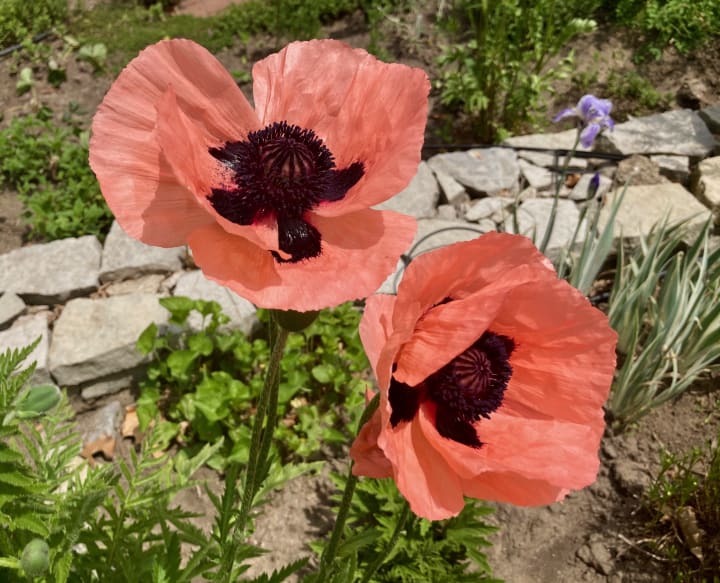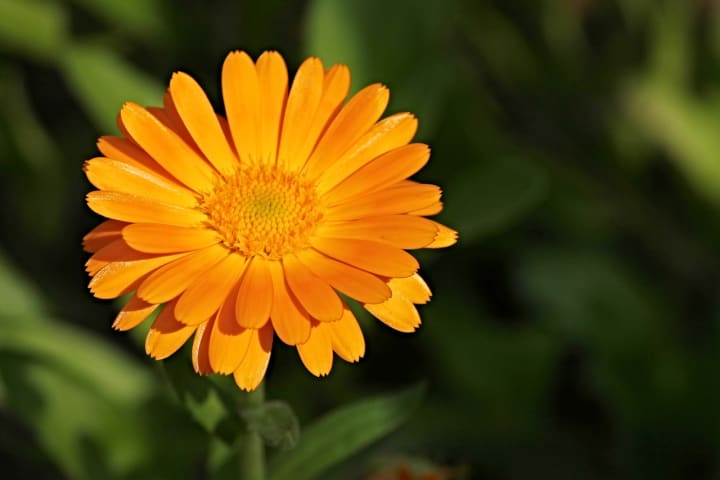Stinking Roger
Eighty-six year-old Petal walks through her beautiful flower garden, and remembers her kindergarten students.

A lady with curly purple-white hair wearing a housecoat shuffles down the stone path in her back yard. It’s six a.m., and the birds are still singing their morning greeting to the day. In her right hand is a steaming mug of lemon balm tea, and she is frowning attentively at the moving surface of the hot liquid as she walks along, careful not to spill. In her left hand, she holds a round cushion with tassels at the seams.
She reaches her destination—a white-washed wooden bench with curved iron arm rests. She plops the cushion down onto it and slowly takes a seat, letting out a loud sigh of contentment when her bottom finally lands.
The morning is still, and the pale morning sun promises warmth for later today. The woman’s garden is just waking up. This is her happy place. She sips her tea.
Her name is Petal Jacobs. She’s always loved being named after a part of a flower, and figures that’s why she loves gardening so much. Maybe if her mother had named her Pearl eighty-six years ago, she would live by the sea and collect beautiful shells. But as it turns out, her true love is botany.
“They say if you’re a good gardener, you have a green thumb,” Petal would tell her students, “But I love flowers so much, my heart is green too.”
Some of the kindergarteners would look at her with puzzled expressions, and she would wink at them. She loved “her kids” as she called them, as much as her garden. Petal didn’t have children of her own—she never married—but she always felt that, in a way, her years of teaching kindergarten gave her a glimpse into what parenthood was like.
She cared deeply about her students, and tended each child as she would a special plant.
“Every type of flower needs a unique set of conditions for it to thrive best in,” she would explain to her colleagues in the lunch room.
“You can’t put sunflowers in the shade if you expect them to grow to their fullest. They need to follow the sun. But most begonias like it better in dappled light through the trees. You have to listen for what each one needs. Same’s true with the kids. Shy little Sam keeps his mouth clamped shut when I get the children singing, while Gloria will belt it out as loud as she can to drown out the other voices. So I make sure we have some quiet reading time too; Sam just loves that.”
The other teachers were used to Petal’s botanical analogies, and would nod and smile patiently as she enlightened them about the colourful characters in her classroom.
Now Petal sits on her bench, gazing around at the garden she has been tending for decades. It’s a wonder to behold—if Petal did say so herself, quite often—with its many tiers of blossoms and foliage creating a full composition that, if you were sitting on the bench, made you feel like you were being enveloped in its colourful, thriving embrace.
There are cascades of nasturtiums, impatiens and strawberries pouring from baskets, which lead the eye downwards to tiger lilies, peonies and a huge patch of bright fuscia bee balm.
Petal notices the bees are already awake, buzzing in and out of the many blooms, their fuzzy bodies collecting pollen. A few butterflies flutter through the air, making delicate landings on flower heads, and sticking in their strange curled-up proboscis-tongues to drink the sweet nectar.
At the back of the garden, tall stands of multi-coloured hollyhocks create a container for the shorter plants in front. Sedges and buttercups peek out between several types of ferns; clumps of daisies, bright orange calendula, and pink and red poppies dance amidst decorative grasses. There are pockets of violets and snowdrops, forget-me-nots and friendly yellow marigolds.
Finished her tea, Petal stands up, and begins her routine walk into the world she’s created, down through the lavender, sage and rosemary towards the pond. She breathes in their pungent aromas, as her bare feet walk on white clover and flowering thyme. The pond is surrounded by sweetgrass, jewelweed, milkweed, and little wild strawberries.
She loves all her flowers, but there are a few special ones in the mix, which remind her of certain former students from her classes over the years.
Her hand brushes across the lacy pink poppies, a variety called Helen Elizabeth. Petal had been “tickled pink,” she remembers cleverly putting it, in the summer of 1982 when she’d read her class roster for the upcoming year and learned that there would be a set of twins in her class named Helen and Elizabeth. Much to her delight, Helen was wearing a lovely crinkly pink dress on the first day of school, and both girls had dark brown eyes and hair.

There had been two other kids in the class that year with flower names— Daisy and Violet—and Petal had grouped the four of them together at one table, as she might curate a garden. The other children had been seated at tables according to whatever colours they were wearing that day, creating an aesthetic that was pleasing to Petal’s practiced eye.
Perhaps I’ll rearrange the seating daily, she had thought, It will be like planting into fresh soil every morning.
There was one boy whose dirty grey t-shirt hadn’t really fit in anywhere, so Petal sat him with the four flower-girls, since they hadn’t been arranged by colour anyway.
That boy was Roderick, the one who ate glue, licked it right off the Popsicle stick.
“Roderick!” Petal had told him once, “Don’t put that in your mouth; you might get sick. The glue is for our craft today, not for lunch.”
A couple of the other kids had laughed and pointed, and Roderick had dropped his head in shame. Petal instantly regretted that she had chastised him in front of the class rather than going over to his table and telling him quietly.
But the damage had been done, she saw, so she became determined to make it up to him. She would go out of her way to compliment his drawings—which were very good—so that the other students would hear her. She called on him whenever he put his hand up, and offered him first pick of the musical instruments at Jam Time. She hoped her favouritism wasn’t noticeable to the other children; she only wanted to include him, the quiet outsider, to make him feel seen in his faded old hand-me-downs, amidst the sea of his brightly-coloured peers.
Now Petal stops and looks at the white, tube-like flowers growing upwards from a clump of dark green, variegated leaves. This is a cluster of marigolds, planted for Roderick. When she had found this particular variety—stinking Roger—she thought that although it was not quite his namesake, it was close enough.
Many people would call this plant a weed; it was not as showy as the other members of her garden, and it had a strong smell. But it quietly worked to fend off nematodes, and she sometimes used its leaves to season potatoes. And if you took the time to look closely at the cylindrical flowers, you would find they were actually quite beautiful.
She knew some people might think her cruel to plant a flower called stinking Roger to represent one of her students, but Petal didn’t see it this way—it just reminded her of him. The pale colour of the flowers was like his grey t-shirt. And, like the flower, not everybody looked closely enough to appreciate Roderick’s beauty, or notice what he really needed.
She looks now at her prolific calendula, which she also planted for Roderick. Calendula is a flower for happiness, with its orange so bright it almost seems to glow with an internal light.

One hot day in June, Roderick showed up wearing a long-sleeved sweater. After lunch Petal could see that there was perspiration dampening the hair at his temples, and a few drops of sweat dotting his brow. Not wanting to centre him out, she called him to the coat room during craft time.
“Roderick, why don’t you take off your sweater?”
It took some convincing—at first he insisted he was fine—and when he finally relented and pulled the sweater over his head, Petal saw there were bruises on his pale little arms. Dark, ugly bruises shaped like fingers.
She had knelt down in front of him and asked, “Sweetheart, how did you get these bruises?”
Roderick dropped his eyes and shrugged his shoulders.
“Did somebody grab your arm really hard?”
He shook his head fiercely, and Petal saw a tear fall from the end of his nose.
“Roderick, it’s okay. You can tell me. You are with me now, and you are safe.”
He stayed quiet, but suddenly he wrapped his small arms around her neck and squeezed her tight, and she felt his body shaking with silent tears. Her own eyes filled up, but she blinked the tears away and stood up.
“Okay, honey, why don’t you come with me?”
Petal called the librarian, Mrs. Finch, on the intercom, and asked her to take over in the classroom. Then she walked hand in hand with Roderick to the main office. She left him with a friendly young secretary who had lollipops at her desk, and went in to tell the principal—Mr. Bane—what she had seen. He had called Children’s Aid, and was told that an agent would come to the school immediately.
Mr. Bane suggested that they keep Roderick in the office to wait, since the agent would be there within the half hour. When Petal left Mr. Bane’s office, Roderick and the secretary were not in the reception area. Petal guessed that Miss Daley had taken Roderick to the washroom, so she went back to her classroom.
Petal hadn’t seen Roderick again. At one point later that afternoon, while she was reading a book to the class on the carpet, she saw Miss Daley sneak quietly into the back of the room so as not to disturb story time. She nodded to Petal, then discretely collected Roderick’s things from the coat room—he must have told her what his back pack looked like—and tip-toed out again.
As her eyes followed Miss Daley, her mouth never stopped speaking the words of the story:
“Four little ducklings floating in a row, spot some little fish and off they go,
Watch them dive and splash and play, but one little duckling paddles away…”
She wishes now that she had stopped reading, and found the toy horse that Roderick liked to play with, or the bean-shaker he always chose when the class played music. She wishes she had sent him with a small token of her care, a little piece of something familiar. But how was she to know he wouldn’t ever be coming back?
When Roderick wasn’t in class the next day, Petal sought out Mr. Bane at first recess break to ask what had happened.
“An agent came yesterday, with a police officer. They asked Roderick some questions. He didn’t say much, but given his bruises, the CAS worker thought it best to take him with her right then. She said they would start the investigation right away.”
From that day on, there was an empty chair at the flower girls’ table.
Standing in her garden now, Petal plucks one of the calendula flowers and brings it to her nose, inhaling deeply. She loves the spicy-sweet, sophisticated aroma of this happiness flower. As she has done so many times over the years, Petal wishes joy for Roderick, and hopes that wherever he is today, he is doing alright.
She looks up, and spots a group of fiery orange Greigii tulips.
Now Greg, she remembers with a twinkle in her eye, was he ever a trouble-maker…

About the Creator
Kate Sutherland
Kate is a Song-writer, an Artist, and a Kung Fu Teacher. She loves exploring a multitude of creative paths, and finds joy in inspiring others to do the same.






Comments
There are no comments for this story
Be the first to respond and start the conversation.